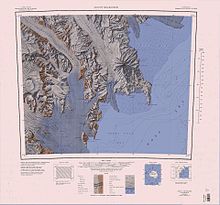Northern Foothills
| Northern Foothills | |
|---|---|
| Geography | |
| Continent | Antarctica |
| Region | Victoria Land, Antarctica |
| Range coordinates | 74°44′S 163°55′E / 74.733°S 163.917°E |
| Parent range | Deep Freeze Range |
Northern Foothills (74°44′S 163°55′E / 74.733°S 163.917°E) is a line of coastal hills on the west side of
Location
The Northern Foothills are separated from the rest of the Deep Freeze Range by the
Features

Features of the Northern Foothills, from north to south, include Mount Browning, Mount Abbot, Cape Canwe, Vegetation Island, Cape Confusion, Hells Gate, Hells Gate Moraine,
Mount Browning
74°37′S 164°03′E / 74.617°S 164.050°E. A mountain, 760 metres (2,490 ft) high, which rises opposite the terminus of
Mount Abbot
74°42′S 163°50′E / 74.700°S 163.833°E. A mountain 1,020 metres (3,350 ft) high, which stands 3 nautical miles (5.6 km; 3.5 mi) northeast of Cape Canwe and is the highest point in the Northern Foothills. Mapped by the Northern Party of the BrAE, 1910-13, and named for Petty Officer George P. Abbott, RN, a member of the expedition.[4]
Cape Canwe
74°43′S 163°41′E / 74.717°S 163.683°E. A high rock bluff 3 nautical miles (5.6 km; 3.5 mi) north of Vegetation Island, forming the west extremity of the Northern Foothills. First explored and named by the Northern Party of the BrAE, 1910-13. The name arose from seeing this feature a long way off and wondering whether they could reach it.[5]
Vegetation Island

74°47′S 163°37′E / 74.783°S 163.617°E. A narrow island lying 2 nautical miles (3.7 km; 2.3 mi) north of Inexpressible Island and just west of the Northern Foothills. Discovered by the Northern Party of the BrAE, 1910-13, who named it because the rocks were densely covered with lichens.[6]
Cape Confusion
74°50′S 163°50′E / 74.833°S 163.833°E. A rocky point which projects from the southwest part of the Northern Foothills, 4 nautical miles (7.4 km; 4.6 mi) northwest of Cape Russell. Visited by the Southern Party of the New Zealand Geological Survey Antarctic Expedition (NZGSAE), 1962-63, which gave the name because of the complex geological structure of the area.[7]
Hells Gate
74°51′S 163°48′E / 74.850°S 163.800°E. A narrows located near the east edge of the Nansen Ice Sheet, lying just north of Evans Cove between Inexpressible Island and the Northern Foothills. First explored and mapped by the Northern Party of the BrAE, 1910-13, who gave the feature this expressive name.[8]
Hells Gate Moraine
74°52′S 163°48′E / 74.867°S 163.800°E. The glacial moraine at Hells Gate, at the head of
Cape Russell
74°54′S 163°54′E / 74.900°S 163.900°E. A rock cape in Terra Nova Bay, forming the south extremity of the Northern Foothills. Named by the United States Advisory Committee on Antarctic Names (US-ACAN) for Lieutenant Commander R.E. Russell, United States Navy, officer in charge of the helicopter unit aboard the icebreaker Glacier in this area during United States Navy Operation Deep Freeze, 1958-59.[9]
See also
- Zucchelli Station, an Italian seasonal research station at Terra Nova Bay on a granitic headland along the coast of the Northern Foothills to the north-east of Gerlache Inlet.
References
- ^ Alberts 1995, p. 532.
- ^ a b Mount Melbourne USGS.
- ^ Alberts 1995, p. 97.
- ^ Alberts 1995, p. 1.
- ^ Alberts 1995, p. 117.
- ^ Alberts 1995, p. 778.
- ^ Alberts 1995, p. 148.
- ^ a b Alberts 1995, p. 326.
- ^ Alberts 1995, p. 638.
Sources
- Alberts, Fred G., ed. (1995), Geographic Names of the Antarctic (PDF) (2 ed.), United States Board on Geographic Names, retrieved 2024-01-30
 This article incorporates public domain material from websites or documents of the United States Board on Geographic Names.
This article incorporates public domain material from websites or documents of the United States Board on Geographic Names. - Mount Melbourne, USGS: United States Geographic Board, retrieved 2024-03-03
![]() This article incorporates public domain material from websites or documents of the United States Geological Survey.
This article incorporates public domain material from websites or documents of the United States Geological Survey.

